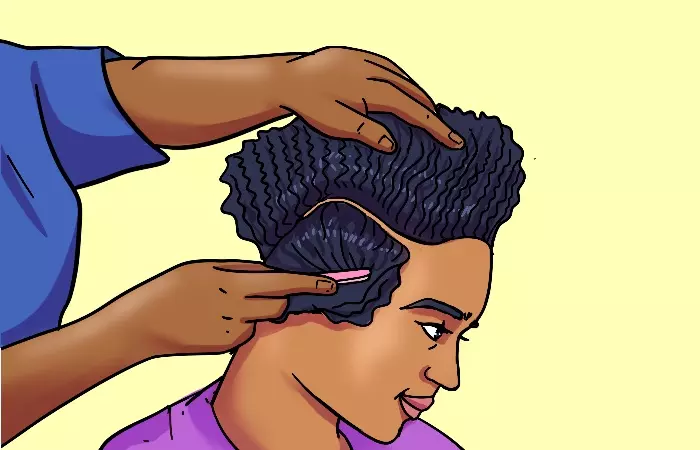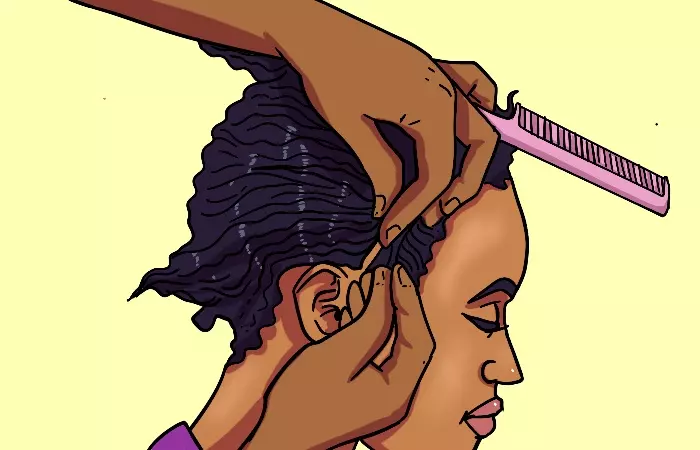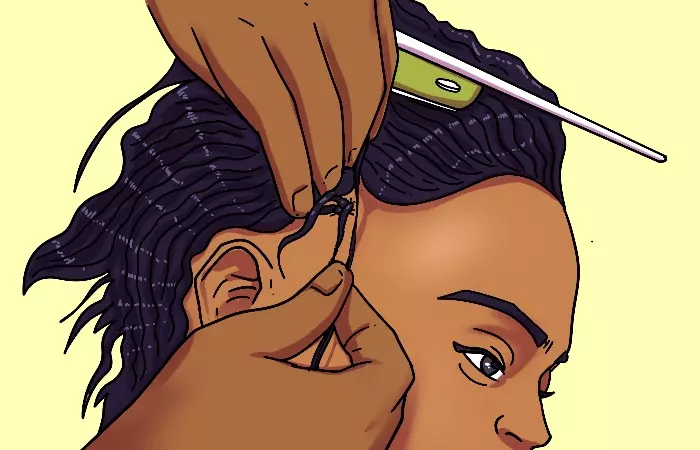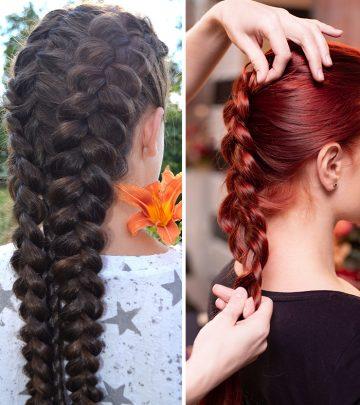How To Do Stitch Braids: Perfecting The Art Of Braiding
Get yourself this crafty protective hairstyle with our easy-to-follow tutorials.

Image: Shutterstock
Looking to give your regular cornrow braids a little bougie twist? Then we are here to teach you how to do stitch braids ??? an edgy and uber-cool variation of the braids that protects your hair, volumizes it, and is super easy to maintain! These braids are categorized as designer braids and have a unique stitch-like pattern that will make your hair look like an embroidered masterpiece. It just needs some patience and some weekly maintenance, and you have a hairstyle to rival celebrity red-carpet looks, gracing your head at all times! So, learn how to stitch braids in simple and detailed steps and discover the maintenance methods. Keep reading to know more.
 Before You Get Started
Before You Get Started- You need to have a minimum of 4 inches of hair length for secure stitch braids and fuller-looking coverage.
- You will need 1-3 jumbo packs of hair extensions to cover a full head of hair.
- Stitch braids are suitable for all hair types. However, your final braid outcome depends on your hair texture and thickness. If you have a fine hair type, opting for a loose braiding style is ideal.
- Stitch braids involve super-tight braiding which can be uncomfortable for sensitive scalps. Discuss your comfort level with your stylist at the beginning of the process.
- The braiding is done on freshly washed, dried, and moisturized, happy hair.
- The entire braiding process is time-consuming, spanning 2-3 hours, depending on your styling requirements. So be prepared to make this commitment.
In This Article
What Are Stitch Braids?

Stitch braids are a unique protective hairstyle that has neat, stitch-like thick or thin lines of hair, achieved by adding braiding hair at frequent, regular intervals. It appears like the extensions have been stitched into the braids. These braids employ organic methods, done by hand, with a lot of product to hold the thick, natural hair and extensions together, and can last for months if maintained properly. Here are a few salient features of stitch braids.
- Unique Stitch-In Look: These braids are much like cornrows, except for the distinct, sharp horizontal lines that go straight across each row of braids, dividing individual stitches of the braid, giving it a stitched-in appearance.
- Versatile Styling: Although the standard braiding style involves straight rows of hair sections, stitch braids are versatile enough for curvy, or creatively shaped braiding lines. The thickness of the braids can be customized as per choice. The braids can also be accessorized using beads and charms that can be easily clipped or removed from the stitches.
- Hair Protection: It is a protective hairstyle where the braids work to protect the hair shaft from the elements, lock in moisturization, and minimize hair loss. Thus, these braids promote healthy hair growth.
- Long-Lasting: Stitch braids that are washed and maintained properly can last for several weeks to two months. So, it is a good solution to manage brittle hair types for individuals who cannot make time for regular styling.
- Suitable For All Hair Types: Although stitch braids are primarily intended to protect natural hair types, they may be worn by people with all kinds of hair textures for a protective look that is also stylish and low-maintenance.
Let us move to the next section and learn how to do stitch braids using traditional techniques.
Key Takeaways
- Stitch braids are a variation of cornrow braids and are defined by the stitch-like striations dividing each braid.
- These braids can be done using the beginner-level rubberband technique which uses rubberbands to secure individual stitch sections, or the advanced comb and finger technique done skillfully using the fingers.
- Stitch braids are low maintenance and can last for up to two months. However, they need weekly or biweekly shampooing and conditioning, and moisturizing 2-3 times a week.
How To Do Stitch Braids

There are two ways to achieve stitch braids for your hair. They are as follows.
1. The Rubberband Technique
The rubber band technique is a beginner-friendly method of doing stitch braids. As the name suggests, it is done using a lot of rubber bands that hold individual stitches in place. Here is a step-wise tutorial for this technique.
What You Need
- Rat tail comb
- A big pack of rubber band elastics
- Hair extension packs (1-3 jumbo packs depending on requirement)
- Hair-holding product of choice (hair wax, gel, jam, edge control, etc.)
How To Do
- Create Hair Sections

Start with freshly washed hair. Use a rat tail comb, and divide your hair into long sectioned rows from crown to nape. The thickness of the sections can be per your preference.
- Apply Holding Product

Apply a generous amount of holding product at the roots of each section to make your hair slick, neat, and manageable for styling.
- Create Horizontal Sections With Rubber Bands

Start with one section at a time. Use the rat tail comb to divide a horizontal section of 1-2 cm, across the long section, and secure it with a rubber band. Continue till the nape so you have multiple little ponytail sections from the beginning to the end of the row.
- Stitch The Horizontal Sections

Take two horizontal sections at a time, beginning from the crown, and start feeding in the extensions as you braid down the row. Keep adding the following horizontal sections into your stitch braid as you reach them. Secure the braid with another rubber band when you are satisfied with the length.
- Complete The Braids

Repeat steps 3 and 4 for the rest of the sectioned rows and your stitch braids are ready!
 Pro Tip
Pro TipIf you are someone with ample experience with protective styles, you need not use all those rubber bands and directly use your hands for the braiding. The following technique tells you how to do stitch braids using a comb and your fingers.
2. The Comb/Finger Technique
This band-less technique is for advanced braiders who can weave protective styles with their hands the traditional way. Here is how it is done.
What You Need
- Rat tail comb
- Hair extension packs (1-3 jumbo packs depending on requirement)
- Hair-holding product of choice (hair wax, gel, jam, edge control, etc.)
How To Do
- Create Hair Sections

Start with freshly washed, dried, and moisturized hair. Use the rat tail comb to divide long sectioned rows from crown to nape. You may decide how thick you want each section to be.
- Apply Holding Product

Apply a generous amount of holding product to the roots of each section for ease of managing and styling.
- Create Horizontal Sections With Comb/Finger

Begin with one sectioned row at a time. Use the rat tail comb to create your first horizontal section and make 2-3 braid stitches.
- Create A Row Of Horizontal Sections

Continue making individual horizontal section braids till the nape.
- Stitch In The Extensions

Now, add the extension at the first stitch and braid it into your section.
- Stitch The Horizontal Sections With The Extensions

Use the comb or your fingers to divide the next horizontal section and stitch it in with the initial braid. Continue dividing horizontal sections and adding them in as you go until you reach your nape. You may continue like a regular braid after you have created the stitches along the scalp and secure them with a rubber band.
Repeat steps 3-4 for the rest of the sectioned rows. Your bandless stitch braids are ready to flaunt! If you are attempting these braids for the first time, practice on a mannequin or someone else’s hair a few times, until you get a hold of the technique. Start with smaller and thinner hair sections and gradually increase the thickness as you get comfortable.
Stitch braids look intricate and difficult to achieve. Rightfully so. Acute knowledge of braiding and an eye for symmetry is essential to perfect the style. Both beginners and experienced hairstylists commit some mistakes when they try to do this braiding style. We have listed the common pitfalls below to help you understand what to avoid.
Common Mistakes To Avoid When Making Stitch Braids
When creating stitch braids, you must be mindful of avoiding these common mistakes. They can affect the overall appearance of the hair and even impact your hair health in the long run. Check out the mistakes below.
- Forgetting to moisturize the scalp before braiding. A dry scalp contributes to dry strands and braiding rough hair means excessive breakage.
- Dividing the hair into uneven sections. Failing to make even sections can mess up the final look.
- Braiding too tightly by pulling on the strands. This will cause discomfort and result in an asymmetrical and untidy look.
- Not trimming the hair ends. If you don’t trim the excess hair at the end, the final look will be messy and unfinished.
Braiding your hair in perfect stitch patterns is a matter of time and concentration. Before going through so much effort, you might want to know how long would these braids last. Check out the next section to know all about it.
How Long Do Stitch Braids Last?
The longevity of this type of braid largely depends on various factors such as hair texture and hair health. Proper hair care is also crucial in extending the braids’ lifespan significantly. Well-maintained stitch braids can last up to two months. Additionally, your hair growth rate may also play a pivotal role in its longevity. If your hair grows out faster, the braids will loosen quickly and need a touch-up to ensure they are tight and neat again.
To make them last long, you need to take care of these braids. Check out the next section to learn more about caring tips.
How Do I Care For My Stitch Braids?

As a protective hairstyle, stitch braids are fairly low maintenance. But that does not mean you can be negligent in caring for it. Here are a few maintenance tips that will ensure the longevity and freshness of your stitch braids for several weeks.
- Shampooing
You need to shampoo your roots once a week or two to prevent buildup, odor, and itching. Simply use a cloth dipped in diluted shampoo to gently scrub the scalp and roots, without disturbing the braids. Then use another cloth dipped in warm water to clear the suds. Rinse thoroughly and pat dry with a clean microfiber towel to remove excess water.
- Conditioning
Conditioning is extremely important to avoid overdrying of the scalp after the shampooing. Opt for a lightweight conditioning product that is specifically made for protective braids or your hair type and focus on the roots. Do this step after every washing session.
 Quick Tip
Quick Tip- Drying
After you do your wet treatments, it is important to ensure your hair dries properly to avoid mold or mildew on your natural hair shaft. Always dab excess moisture out from the braids and roots. In humid or cold weather conditions, you may use a blow dryer at the lowest temperature to dry your braids, otherwise, simply air dry.
- Moisturizing
Hydration or moisturization is a necessary step to ensure your hair does not dry out between washes and your hair continues to grow healthily. Get a good-quality, lightweight leave-in moisturizing spray or oils and apply it 2-3 times a week as per package instructions.
Besides these major maintenance steps, here are a few other tips you can follow to ensure your braids continue to look fresh and neat while they last.
- Avoid pulling or tugging at the braid. Stitch braids tend to be heavy because of the stitched-in extensions, so discuss how tight you want them to be with your stylist beforehand.
- Wear a satin or silk bonnet to bed every night to protect them while you sleep. It will help avoid frizz and damage from rubbing against rough fabrics.
- Avoid heavy styling products to prevent buildup and weighing down of braids that will eventually loosen and also weaken your hair roots.
- Get touch-ups if you notice your braids have started loosening or unraveling to ensure they look tight, fresh, and shiny.
These tips are basic and easy to follow. Set yourself a good haircare regime and schedule so you can make the best out of your stitch braids.
So, that was all you need to know about mastering the art of stitch braiding. We covered step-by-step tutorials of two popular methods of doing these braids. If you are a newbie, then the rubberband technique will help you ease into the process. If you are a seasoned braiding artist, then the finger and comb technique will be a walk in the park for you. Keep in mind that for a neat and secure braiding coverage, you need at least 4 inches of hair growth, lots of hair-holding product, and mental preparation to sit through 2-3 hours of the braiding process. Ensure a good braid-care maintenance regime involving shampooing, conditioning, moisturizing, and drying, to keep your braid in top shape until you need to get a touch-up.
Frequently Asked Questions
Can I do stitch braids on short hair?
Yes, you can do stitch braids on short hair, but the short length may significantly impact the style’s overall appearance. Try to create tiny but neat stitch patterns to get a defined look. However, if you want naturally defined patterns, add extensions to your short hair.
What is the best hair for braiding stitch braids?
The best hair extensions for stitch braids vary as per individual styling and budget requirements. Some popular hair extension type choices include human hair, Afrelle, Kanekalon, and Xpression.
What is the difference between stitch braids and feed-in braids?
In stitch braid, there is a unique sectioning technique done using rubberbands or comb and fingers, while adding extensions, to make it appear like stitches. Feed-in braiding requires adding extensions as you continue braiding but does not focus on the stitch-like sectioning.
If you are a beginner at protective braiding, you might find a visual guide more helpful to grasp the tiny details of the technique. Check out the following video where a stylist demonstrates how to do stitch braids the traditional way.
Read full bio of Laura Dale
Read full bio of Aparna Harry
Read full bio of Asmita De
Read full bio of Joyce Joyson





















Community Experiences
Join the conversation and become a part of our empowering community! Share your stories, experiences, and insights to connect with other beauty, lifestyle, and health enthusiasts.